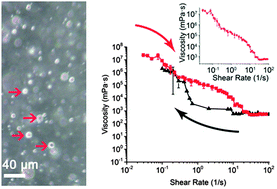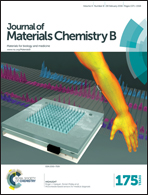Complex coacervates of oppositely charged co-polypeptides inspired by the sandcastle worm glue†
Abstract
Sandcastle worms secrete a water-resistant proteinaceous glue that is used to bind mineral particulates into their protective tubing. Previous proteomics studies have shown that the constitutive proteins of the glue are oppositely charged co-polypeptides that form a complex coacervate precursor phase, which is critical for stable underwater delivery of the adhesive. Using ring-opening polymerization (ROP) from N-carboxyanhydride (NCA) monomers, we synthesized oppositely charged co-polypeptides that mimic the amino acid composition and molecular weight of the native glue-forming proteins. The synthesis strategy enabled the incorporation of non-standard phosphoserine (pSer) and 3,4-Dihydroxyphenylalanine (Dopa) amino acids in the co-polypeptides, thereby duplicating chemical functionalities of the native glue that are key for electrostatic complexation and adhesion. Complex coacervates were obtained from these oppositely charged co-polypeptides, thus mimicking the self-assembly process of the native adhesive secreted by the sandcastle worm. Varying the relative ratio of the co-polypeptides enabled the fine-tuning of coacervation conditions such as pH and ionic strength. Wetting and rheological characterization demonstrated that our oppositely charged co-polypeptide complexes exhibited the key features associated with coacervates, namely, low surface tension, shear thinning behaviour, and viscoelastic response, making these sandcastle worm glue-inspired polypeptide coacervates a suitable modality for water-resistant bioadhesives.


 Please wait while we load your content...
Please wait while we load your content...